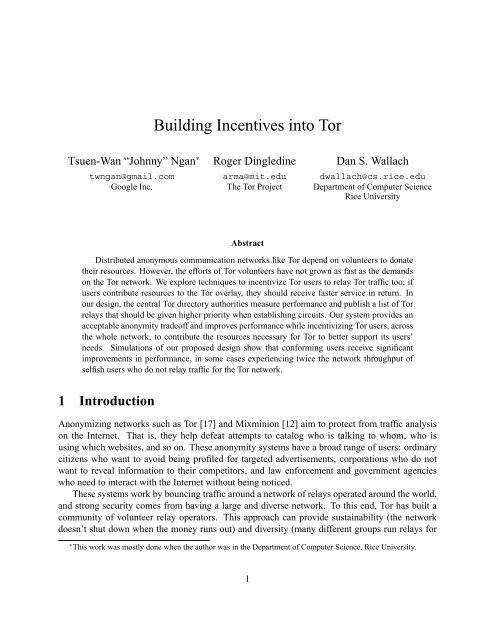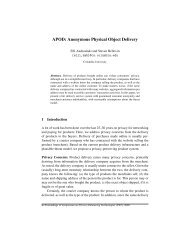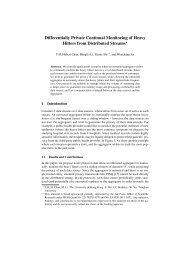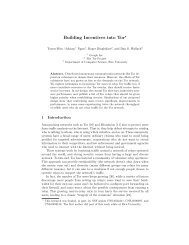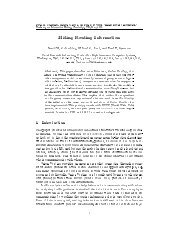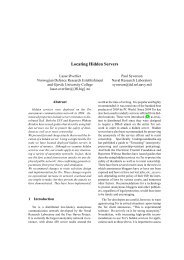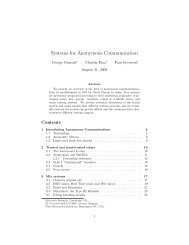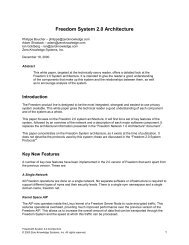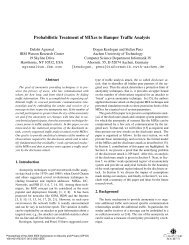Building Incentives into Tor - The Free Haven Project
Building Incentives into Tor - The Free Haven Project
Building Incentives into Tor - The Free Haven Project
You also want an ePaper? Increase the reach of your titles
YUMPU automatically turns print PDFs into web optimized ePapers that Google loves.
Selfish. <strong>The</strong>se nodes never relay traffic for others. <strong>The</strong>y are freeloaders on the <strong>Tor</strong> system with500KB/s of bandwidth.Cooperative slow. <strong>The</strong>se nodes follow the same policy as cooperative nodes, but with only50KB/s of bandwidth.Cooperative reserve. <strong>The</strong>se nodes have 500KB/s bandwidth, just like cooperative nodes, but captheir relaying at 50KB/s, saving the remainder for traffic that they originate.Adaptive. <strong>The</strong>se nodes will be cooperative until they get a gold star. After this, they will beselfish until they lose the gold star.All of our simulations use ten directory authorities. To assign the gold star status, every minuteeach directory authority will randomly build a circuit with three <strong>Tor</strong> relays and measure its bandwidthby downloading a small, known 40KB file from an external server. <strong>The</strong> bandwidth measurementis recorded and attributed to only the middle relay in the circuit. (In a genuine deployment,the entry and exit nodes would be able to determine that they were being measured by virtue ofbeing connected to known measurement nodes and could thus change their behavior in response.)To obtain a gold star, we require <strong>Tor</strong> relays to successfully relay traffic at least two times out of thelast five measurements (i.e., k = 2 and n = 5 from Section 4). A relay is defined as successful ifthe directory authority can receive the correct file within a reasonable amount of time.For our results, we describe the observed network performance in terms of “download time”and “ping time.” Download time describes the time for nodes to download a 100KB file from anexternal server. Ping time describes the round-trip latency for that same external server. (Thisexternal server is assumed to have infinite bandwidth and introduce zero latency of its own.) Bothmeasures are important indicators of how a <strong>Tor</strong> user might perceive <strong>Tor</strong>’s quality when web surfing.For contrast, a <strong>Tor</strong> user downloading large files will be largely insensitive to ping times, caring onlyabout throughput.5.2 Experiment 1: Unincentivized <strong>Tor</strong>First, we want to understand how <strong>Tor</strong> networks behave when demand for the network’s resourcesexceeds its supply. We simulated 50 cooperative relays, 50 selfish relays, and 50 cooperativereserve relays with heavy background traffic (20 Bit<strong>Tor</strong>rent clients and 2000 web clients).Figure 1 plots the average download and ping time for each relay type. Each plotted point isthe average for 50 raw samples. Despite this, the variation among the data points suggests that thenetwork performance is highly variable.To get a better view of the distribution of download times and ping times, we use cumulativedistribution functions (CDFs). Figure 2 represents the same data as Fig. 1, albeit without any of thedata-point averaging. <strong>The</strong> x-axis represents download time or ping time and the y-axis representsthe percentage of nodes who experienced that particular download or ping time or less.7
Download time (seconds)2018161412108642CooperativeSelfishCooperative reservePing time (seconds)12108642CooperativeSelfishCooperative reserve00 200 400 600 800 1000 1200 1400Simulation time (minutes)00 200 400 600 800 1000 1200 1400Simulation time (minutes)Figure 1: Average download and ping time over time when no incentive scheme is in place andheavy traffic (20 Bit<strong>Tor</strong>rent clients and 2000 web clients). Both download and ping time showsignificant variation, regardless of relay type.110.80.8Cumulative fraction0.60.4Cumulative fraction0.60.40.200.512CooperativeSelfishCooperative reserveDownload time (seconds)510200.200.512CooperativeSelfishCooperative reserve5Ping time (seconds)1020Figure 2: Cumulative download and ping time when no incentive scheme is in place and heavytraffic (20 Bit<strong>Tor</strong>rent clients and 2000 web clients). Performance for all relay types is similar,although selfish relays do somewhat better in the worst case.While the ideal download time for all relay types in this experiment is 0.8 seconds (six networkroundtrip hops plus transmission time), all relay types rarely achieve anywhere close to thisnumber. Figure 2 shows that roughly 80% of the attempted downloads take more than two seconds,regardless of a node’s policy. Approximately 10% of cooperative relays take longer than tenseconds. Selfish nodes, in general, do better in the worst case than cooperative nodes, but observesimilar common-case performance.8
110.80.8Cumulative fraction0.60.40.200.512CooperativeSelfishCooperative slowAdaptiveDownload time (seconds)51020Cumulative fraction0.60.40.200.512CooperativeSelfishCooperative slowAdaptive5Ping time (seconds)10Figure 3: Cumulative download and ping time with the gold star scheme and no background traffic.110.80.8Cumulative fraction0.60.40.200.512CooperativeSelfishCooperative slowAdaptiveDownload time (seconds)51020Cumulative fraction0.60.40.200.512CooperativeSelfishCooperative slowAdaptive5Ping time (seconds)10Figure 4: Cumulative download and ping time with the gold star scheme and heavy backgroundtraffic (20 Bit<strong>Tor</strong>rent clients and 2000 web clients). Cooperative nodes maintain their performance,while selfish and adaptive nodes suffer.5.3 Experiment 2: Gold starsOur first experiment represents the present-day situation in the <strong>Tor</strong> network and is clearly unsatisfactory.This second experiment measures the effectiveness of our “gold star” mechanism inaddressing this concern. This time, our simulation consists of 40 cooperative relays, 40 selfishrelays, 40 cooperative slow relays, and 40 adaptive relays. <strong>The</strong>se variations, relative to the firstexperiment, also allow us to see whether slower cooperative nodes still get the benefits of a goldstar, and whether adaptive nodes can be more effective than purely selfish nodes. Figures 3 and 4show the cumulative download and ping time with no background traffic and heavy backgroundtraffic, respectively.Our results are striking. Cooperative nodes maintain their performance, regardless of the levelof background traffic in the overlay. When there is no background traffic, they slightly outperformthe selfish and adaptive nodes, but once the traffic grows, the cooperative nodes see clear improve-9
110.80.8Cumulative fraction0.60.40.200.512CooperativeSelfishCooperative reserveAdaptiveDownload time (seconds)51020Cumulative fraction0.60.40.200.512CooperativeSelfishCooperative reserveAdaptive5Ping time (seconds)10Figure 5: Cumulative download and ping time with the gold star scheme and heavy backgroundtraffic (20 Bit<strong>Tor</strong>rent clients and 2000 web clients). Cooperative reserve relays, which replaced thecooperative slow relays, have similar performance to fully cooperative relays.ments. For example, under heavy background traffic, 80% of the cooperative nodes see downloadtimes under two seconds, versus roughly 2.5 seconds for the selfish and adaptive nodes.Our experiment also shows that the adaptive policy does not defeat the gold star mechanism.Adaptive nodes will experience better performance while they have a gold star, but their benefitonly splits the difference between the cooperative and selfish policies, roughly in proportion to theeffort they are spending to maintain their gold star.Cooperative slow nodes are always relatively slow due to their limited available bandwidth.However, like their fast counterparts, they experience stable performance as the background loadon the <strong>Tor</strong> network increases. This demonstrates that the gold star policy can effectively rewardgood behavior, regardless of a node’s available bandwidth.We conducted a further experiment, replacing the cooperative slow nodes with cooperativereserve nodes, representing a possibly rational response to the gold star mechanism. <strong>The</strong>se nodesuse 10% of their bandwidth for relaying and earning a gold star, reserving 90% of their bandwidthfor their own needs. Figure 5 show the results of this experiment. Both kinds of cooperativenodes observe identical distributions of bandwidth and latency. Selfish and adaptive nodes sufferas the background traffic increases. This experiment shows, unsurprisingly, that nodes need notbe “fully” cooperative to gain a gold star. In an actual <strong>Tor</strong> deployment, it would become a policymatter, perhaps an adaptive process based on measuring the <strong>Tor</strong> network, to determine a suitablecutoff for granting gold stars (see Sect. 6.1).5.4 Experiment 3: Alternating relaysThis experiment considers a variation on the adaptive strategy used in the previous experiments.Alternating nodes will toggle between the cooperative and the selfish strategies on a longer timescale—four hours per switch. This experiment uses 50 such alternating relays with 50 cooperative relays10
Download time (seconds)654321CooperativeAlternatingPing time (seconds)32.521.510.5CooperativeAlternating00 200 400 600 800 1000 1200 1400Simulation time (minutes)00 200 400 600 800 1000 1200 1400Simulation time (minutes)Figure 6: Average download and ping time with relays that alternate between being cooperativeand selfish. This experiment is with the gold star scheme in place and heavy background traffic(20 Bit<strong>Tor</strong>rent clients and 2000 web clients). Dotted lines show the times at which the alternatingrelays switch. <strong>The</strong> performance of alternating relays gets worse whenever they switch to beingselfish, while performance for cooperative relays only suffers a little.and with heavy background traffic (20 Bit<strong>Tor</strong>rent clients and 2000 web clients).Figure 6 shows the average download and ping time for both relay types over time. During theperiods where the alternating relays are cooperative, they receive service of a similar quality as thefull-time cooperative nodes. However, once the alternating relays switch to become selfish, theirdownload times quickly increase, representing the same quality of service that would be observedby a selfish node. Note that while the cooperative nodes do observe lower quality of service (afterall, fully half of the <strong>Tor</strong> nodes stopped relaying any data), they still do much better than their selfishpeers. Our gold star system robustly responds to changes in node behavior.5.5 Experiment 4: Pair-wise reputationLast, we investigated a variation on our gold star design where individual circuits are not labelledas being low or high priority. Rather, each circuit inherits its priority from the status of the previousrelay. That is, a low-priority node routing traffic through a gold-star node will experiencepriority delays getting the gold-star node to accept the traffic, but the traffic will have high priorityin its subsequent hops. This alternative design has significant improvements from an anonymityperspective, because traffic at a given hop does not give any hint about whether it originated froma low-priority or high-priority node. However, our experiment showed selfish nodes clearly outperformingtheir cooperative peers. <strong>The</strong> results are shown in Appendix B.11
6 DiscussionOur experiments show that our “gold star” technique is effective at giving higher priority to userswho contribute to the <strong>Tor</strong> network. Nonetheless, a variety of questions remain about the policy thatshould be used for assigning gold stars and how the policy may affect the behavior of strategic <strong>Tor</strong>users.6.1 Strategic usersOur proposed incentive scheme is not perfectly strategy-proof, in the sense that users can earn agold star without providing all of their network capacity for the use of the <strong>Tor</strong> network (as in the“cooperative reserve” policy discussed in Sect. 5.3). This creates a variety of possible strategicbehaviors.Provide borderline or spotty service. A relay needs to provide only the minimal amount ofbandwidth necessary to gain the gold star. Of course, if every user provided this amount, <strong>Tor</strong>would still have vastly greater resources than it does today. Next, because the bandwidth policiesare determined centrally, the minimum bandwidth necessary to obtain a gold star could be movedup or down in response to network congestion. Strategic nodes will then adjust the capacity theygive to the <strong>Tor</strong> network, making more bandwidth available whenever they are needed.Only relay at strategic times. Strategic users might provide relay services only when the “local”user is away, and thus not making demands on the <strong>Tor</strong> network. Such behavior is not disincentivizedby our research, as it still provides scalable resources to the <strong>Tor</strong> network. However, anyusers following such behavior may be partially compromising their anonymity, as their presenceor absence will be externally observable.Share a relay among several users. Several users could share a single entry relay <strong>into</strong> the <strong>Tor</strong>network, thus inheriting its gold star benefits without providing any additional bandwidth to the<strong>Tor</strong> network. In fact, we may even want to support this design, so users can run a fast relay at acolocation facility and then reap the rewards from their slower cable-modem or DSL <strong>Tor</strong> client. Toallow the client to inherit the reputation of the server, the relay could be configured to give highpriority to allow connections from a given set of IP addresses or identity keys. On the other hand,multiple users that use a shared entry point must be able to trust one another. Lacking such trust,their desire for personal anonymity would incentivize them to run individual <strong>Tor</strong> relays.Accept traffic only from known relays. In our design the directory authorities do their measurementsanonymously via <strong>Tor</strong>, so all audits will come from other listed <strong>Tor</strong> relays. Thus astrategic relay could get away with giving poor performance (or no performance at all!) to connectionsfrom IP addresses not listed in the directory. One answer is that some of the measurementsshould be done through unlisted relays, perhaps by gathering a large pool of volunteer <strong>Tor</strong> usersto help diversify the audit sources. Another answer is to turn this vulnerability around and call it afeature—another reason that users should want to get listed as a good relay.12
Forward high-priority traffic as low-priority. A relay who correctly forwards traffic can stillcheat by changing the priority on incoming traffic. <strong>The</strong> measuring authorities should build highprioritytest circuits back to a trusted relay, to see if the circuit arrives with the expected highprioritystatus.6.2 <strong>The</strong> audit arms raceSome attacks outlined above involve relays that provide some level of service but not quite asmuch as we might prefer. <strong>The</strong> response in each case is a smarter or more intensive measurementalgorithm so the directory authorities can more precisely distinguish uncooperative behavior.To see why this won’t be an arms race between increasingly subtle cheating and increasinglysophisticated audits, we need to examine the incentives for ordinary users. <strong>The</strong> most challengingpart of setting up a <strong>Tor</strong> relay is configuring the software, enabling port forwarding in the firewall,etc. Compared to this initial barrier, the incremental cost of providing a bit more bandwidth islow for most users. As long as our audit mechanism correctly judges whether the user relays anytraffic at all, we’re verifying that the user has performed the most personally costly step in settingup a relay. We expect that the diminishing returns a strategic relay gets in saving bandwidth as weprogress down the arms race will limit the complexity required for the auditing mechanism.Measuring whether a relay is forwarding traffic adequately within the network is only one step.We could also extend our auditing techniques to measure whether an exit relay is in fact correctingforwarding exit traffic. We could thus incentivize exit traffic in the same way we incentivize relaytraffic.One concern in any measurement scheme over <strong>Tor</strong> is that the anonymity of <strong>Tor</strong> hides whichnode in an overlay route may have been responsible for degrading the quality of service. Wecould potentially “charge” all of the nodes in the route, but this could lead to “collateral reputationdamage” for innocent nodes. An adversary may even strategically target a node for such damage.This ability to influence reputation can assist in anonymity-breaking attacks [6, 20].6.3 Anonymity implicationsAnonymity metrics like entropy [13, 40] apply to high-latency systems like Mixminion, where aglobal attacker aims to narrow the set of suspects to a small anonymity set (or to a probabilitydistribution that has low entropy). With low-latency systems like <strong>Tor</strong>, most attacks either fail orreduce the entropy to zero. Thus these systems instead measure their security by the probabilitythat a non-global attacker will be in the right positions in the network to launch an attack [44]. Onekey factor in this metric is the number of relays in the network.Assuming the <strong>Tor</strong> network starts out with a small number of gold star relays, whenever a <strong>Tor</strong>relay receives a high priority cell, it knows with absolute certainty that the cell must have originatedfrom a relay having a gold star. With so few gold star relays, the presence of high priority trafficgreatly reduces the number of possible sources for that traffic. Worse, the set of users with a goldstar is made public, further simplifying the attack.13
We believe this tradeoff would still attract many gold star relays, though. First, altruists whodon’t use <strong>Tor</strong> as a client would still be the early adopters, as predicted by Acquisti et al. [1] and asobserved in the current <strong>Tor</strong> network. Low-sensitivity users would come next; many users who caremore about performance than anonymity would be enticed <strong>into</strong> running <strong>Tor</strong> relays. <strong>The</strong> number ofgold star nodes in the system should therefore increase over time, reducing the extent to which thepresence of prioritized traffic gives away information to an attacker. We speculate that the growinganonymity set of gold star relays, along with the improved performance from being in the groupgetting priority traffic, would ultimately be enough to push many mainstream users <strong>into</strong> setting uprelays. So long as there are a sufficiently large number of relays, the effect on anonymity would belimited.Of course, this two-level status classification (“good relay” and “other”) is very coarse. It doesnot differentiate a very fast relay from a moderately fast relay. Our intuition is that splitting <strong>into</strong>two partitions is worthwhile, but the marginal incentives gains from more partitions are outweighedby the marginal damage to anonymity from having smaller sets of users.6.4 <strong>The</strong> economics of attracting more relays<strong>The</strong> experiments in Section 5 show that our design creates significant incentives for users to run<strong>Tor</strong> relays. As we attract more relays, the <strong>Tor</strong> network grows larger. Thus the anonymity that canbe achieved increases for both the relays and the clients. As we attract more relays, the overallcapacity in the network grows too. In fact, if we get a large enough network, the performance willimprove compared to the currently deployed <strong>Tor</strong> network not only for the users who choose to runrelays, but also for the users who don’t!If enough users do choose to run relays that there is excess network capacity, then the observableperformance difference between high priority traffic and regular traffic might be insufficientto get more relays, or even to keep all of the current relays. If such a problem were to occur, oneadditional possibility would be to reserve bandwidth for high-priority traffic [38], effectively throttlinglow-priority traffic and creating a larger incentive for users to get a gold star. <strong>The</strong> downsideto such an approach, of course, is that <strong>Tor</strong> performance would “needlessly” suffer for low-priority<strong>Tor</strong> users.This discussion of the economics of our incentive strategy leaves out many details. We shouldstart by analyzing the various equilibria and deriving utility functions for various user classes. Weleave this investigation to future work.7 Related Work7.1 <strong>Incentives</strong> in anonymous communication networksReal-world anonymizing networks have operated on three incentive approaches: community support,payment for service, and government support. (Discussion of the funding approaches for14
esearch and development of anonymity designs, while related, is outside the scope of this paper.)<strong>The</strong> <strong>Tor</strong> network right now is built on community support: a group of volunteers from around theInternet donate their resources because they want the network to exist.Zero-Knowledge Systems’ <strong>Free</strong>dom network [7] on the other hand was a commercial anonymityservice. <strong>The</strong>y collected money from their users, and paid commercial ISPs to relay traffic. Whilethat particular company failed to make its business model work, the more modest Anonymizer [3]successfully operates a commercial one-hop proxy based on a similar approach. Lastly, the AN.ONproject’s cascade-based network was directly funded by the German government as part of a researchproject. Unfortunately, the funding ended in 2007, so they are exploring the communitysupport approach (several of their nodes are now operated by other universities) and the pay-forplayapproach (setting up commercial cascades that provide more reliable service).Other incentive approaches have been discussed as well. Acquisti et al. [1] argued that highneedsusers (people who place a high value on their anonymity) will opt to relay traffic in order toattract low-needs users — and that some level of free riding is actually beneficial because it providescover traffic. It’s unclear how well that argument transitions from the high-latency systemsanalyzed in that paper to low-latency systems like <strong>Tor</strong>.7.2 <strong>Incentives</strong> in other peer-to-peer networks<strong>Incentives</strong> for applications. Incentive schemes have been proposed for several p2p applications.Bit<strong>Tor</strong>rent [8], one of the pioneers, facilitates large numbers of nodes sharing the effort of downloadingvery large files. Every node will have acquired some subset of the file and will trade blockswith other nodes until it has the rest. Nodes will preferentially trade blocks with peers that givethem better service (“tit-for-tat” trading). Scrivener [35] addresses a more general problem, wherenodes are interested in sharing a larger set of smaller files.In a storage network, nodes share spare disk capacity for applications such as distributedbackup systems. Ngan et al. [36] proposed an auditing mechanism, allowing cheaters to be discoveredand evicted from the system. Samsara [9] enforced fairness by requiring an equal exchange ofstorage space between peers and by challenging peers periodically to prove that they are actuallystoring the data. Tangler [47] required users to provide resources for a probation period before theyare allowed to consume resources.Reputation systems. Resource allocation and accountability problems are fundamental to p2p systems.Dingledine et al. [14] survey many schemes for tracking nodes’ reputations. In particular, ifobtaining a new identity is cheap and positive reputations have value, negative reputation could beshed easily by leaving the system and rejoining with a new identity. Friedman and Resnick [23]also study the case of cheap pseudonyms, and argue that suspicion of strangers is costly. Eigen-Trust [29] is a distributed algorithm for nodes to securely compute global trust values based ontheir past performance. Blanc et al. [5] suggest a reputation system for incentivizing routing inpeer-to-peer networks that uses a trusted authority to manage the reputation values for all peers,comparable to our use of directory authorities.15
Trading and payments. SHARP [24] is a framework for distributed resource management, whereusers can trade resources with trusted peers. KARMA [46] and SeAl [37] rely on auditor sets tokeep track of the resource usage of each node in the network. Golle et al. [25] considered p2psystems with micro-payments, analyzing how various user strategies reach equilibrium within agame theoretic model.7.3 Tradeoff between anonymity and performanceIf the number of gold star relays in the network is small, sending gold star traffic may result inreduced anonymity, albeit better performance. This introduces another dimension of traffic control.In our design a gold star relay is not required to send its own traffic at high priority; it may chooseto send that traffic at a low priority for better anonymity. This tradeoff is similar to the idea inAlpha-mixing [19], where the sender can use a parameter to choose between better anonymity andlower latency.8 ConclusionsThis paper proposes an incentive scheme to reward <strong>Tor</strong> users who relay traffic. Our simulationsshow that we can correctly identify nodes who cooperate with our desired policies, and they achievesizable performance improvements, particularly when the <strong>Tor</strong> overlay is saturated with traffic, asit currently is. While we reduce anonymity for cooperative (“gold star”) nodes because any “highpriority” traffic must have originated from a gold star node, we create significant performanceincentives for many users to join the <strong>Tor</strong> network as relays, which improves both performance andanonymity.Once our technique is ready to be deployed on the live <strong>Tor</strong> network, both pragmatic and theoreticalconcerns remain. For example, we cannot predict future demand on the <strong>Tor</strong> network, norcan we predict the extent to which firewalls or ISP bandwidth policies might interfere with <strong>Tor</strong> orotherwise disincentivize users from relaying <strong>Tor</strong> traffic. We should also investigate the extent towhich the centralized <strong>Tor</strong> management nodes might be able to coordinate their network measurementsand agree on optimal incentivization policies as network conditions evolve.We leave one major obstacle for future work: even if the anonymity set of gold-star users isquite large, changes in the set over time allow intersection attacks on anonymity. That is, if anattacker can link connections by a gold-star user (for example by tracking cookies or logins to awebsite), then the attacker can narrow down which relay is running and has a gold star wheneverone of those connection occurs. One solution might be to make the gold star status persist a whileafter the relay stops offering service, to dampen out fluctuations in the anonymity sets. Dependingon the rate of churn in the <strong>Tor</strong> network, this period might need to be a week or more, which meanswe then need to reevaluate the balance questions from Section 6. For a more radical change, wecould move to an ecash based service where getting high priority is much less related to whetheryou’re running a good relay at the time [2].16
References[1] Alessandro Acquisti, Roger Dingledine, and Paul Syverson. On the economics of anonymity.In Proceedings of the 7th Annual Conference on Financial Cryptography (FC ’03), Gosier,Guadeloupe, January 2003.[2] Elli Androulaki, Mariana Raykova, Shreyas Srivatsan, Angelos Stavrou, and Steven M.Bellovin. Par: Payment for anonymous routing. In Nikita Borisov and Ian Goldberg, editors,Proceedings of the Eighth International Symposium on Privacy Enhancing Technologies(PETS 2008), pages 219–236, Leuven, Belgium, July 2008. Springer.[3] <strong>The</strong> Anonymizer. http://www.anonymizer.com/.[4] Kevin Bauer, Damon McCoy, Dirk Grunwald, Tadayoshi Kohno, and Douglas Sicker. Lowresourcerouting attacks against <strong>Tor</strong>. In Proceedings of the Workshop on Privacy in theElectronic Society (WPES 2007), Washington, DC, USA, October 2007.[5] Alberto Blanc, Yi-Kai Liu, and Amin Vahdat. Designing incentives for peer-to-peer routing.In Proceedings of the 24th IEEE INFOCOM, Miami, FL, March 2005.[6] Nikita Borisov, George Danezis, Prateek Mittal, and Parisa Tabriz. Denial of service or denialof security? How attacks on reliability can compromise anonymity. In Proceedings of CCS2007, October 2007.[7] Philippe Boucher, Adam Shostack, and Ian Goldberg. <strong>Free</strong>dom systems 2.0 architecture.White paper, Zero Knowledge Systems, Inc., December 2000. http://osiris.978.org/˜brianr/crypto-research/anon/www.freedom.net/products/whitepapers/<strong>Free</strong>dom_System_2_Architecture.pdf.[8] Bram Cohen. <strong>Incentives</strong> build robustness in Bit<strong>Tor</strong>rent. In Proceedings of the Workshop onEconomics of Peer-to-Peer Systems, Berkeley, CA, June 2003.[9] Landon P. Cox and Brian D. Noble. Samsara: Honor among thieves in peer-to-peer storage.In Proc. 19th ACM Symp. on Operating System Principles (SOSP ’03), Bolton Landing, NY,October 2003.[10] Mark E. Crovella and Azer Bestavros. Self-similarity in world wide web traffic: Evidenceand possible causes. IEEE/ACM Transactions on Networking, 5(6):835–846, 1997.[11] George Danezis. <strong>The</strong> traffic analysis of continuous-time mixes. In Proceedings of Privacy EnhancingTechnologies workshop (PET 2004), volume 3424 of LNCS, pages 35–50, <strong>Tor</strong>onto,Canada, May 2004.17
[12] George Danezis, Roger Dingledine, and Nick Mathewson. Mixminion: Design of a typeIII anonymous remailer protocol. In Proceedings of the IEEE Symposium on Security andPrivacy, Oakland, CA, May 2003.[13] Claudia Díaz, Stefaan Seys, Joris Claessens, and Bart Preneel. Towards measuringanonymity. In Proceedings of Privacy Enhancing Technologies Workshop (PET 2002).Springer-Verlag, LNCS 2482, April 2002.[14] Roger Dingledine, Michael J. <strong>Free</strong>dman, and David Molnar. Accountability measures forpeer-to-peer systems. In Peer-to-Peer: Harnessing the Power of Disruptive Technologies.O’Reilly and Associates, November 2000.[15] Roger Dingledine and Nick Mathewson. <strong>Tor</strong> protocol specification.https://www.torproject.org/svn/trunk/doc/spec/tor-spec.txt.[16] Roger Dingledine and Nick Mathewson. Anonymity loves company: Usability and the networkeffect. In Proceedings of the Fifth Workshop on the Economics of Information Security(WEIS 2006), Cambridge, UK, June 2006.[17] Roger Dingledine, Nick Mathewson, and Paul Syverson. <strong>Tor</strong>: <strong>The</strong> second-generation onionrouter. In Proceedings of 13th USENIX Security Symposium, San Diego, CA, August 2004.<strong>Project</strong> web site: https://www.torproject.org/.[18] Roger Dingledine, Nick Mathewson, and Paul Syverson. Challenges in deploying lowlatencyanonymity. Technical Report 5540-265, Center for High Assurance Computer Systems,Naval Research Laboratory, 2005.[19] Roger Dingledine, Andrei Serjantov, and Paul Syverson. Blending different latency trafficwith alpha-mixing. In Proceedings of the Sixth Workshop on Privacy Enhancing Technologies(PET 2006), Cambridge, UK, 2006.[20] Roger Dingledine and Paul Syverson. Reliable MIX cascade networks through reputation. InProceedings of the 6th Annual Conference on Financial Cryptography (FC ’02), Southampton,Bermuda, March 2002.[21] John R. Douceur. <strong>The</strong> Sybil Attack. In Proceedings of 1st International Workshop on Peerto-PeerSystems (IPTPS), Cambridge, MA, March 2002.[22] Electronic Frontier Foundation. <strong>Tor</strong>: Legal FAQ for <strong>Tor</strong> server operators.https://www.torproject.org/eff/tor-legal-faq.html.[23] Eric Friedman and Paul Resnick. <strong>The</strong> social cost of cheap pseudonyms. Journal of Economicsand Management Strategy, 10(2):173–199, 2001.18
[24] Yun Fu, Jeffrey S. Chase, Brent N. Chun, Stephen Schwab, and Amin Vahdat. SHARP: Anarchitecture for secure resource peering. In Proc. 19th ACM Symp. on Operating SystemPrinciples (SOSP ’03), Bolton Landing, NY, Oct 2003.[25] Philippe Golle, Kevin Leyton-Brown, Ilya Mironov, and Mark Lillibridge. <strong>Incentives</strong> forsharing in peer-to-peer networks. In Proceedings of the 3rd ACM Conference on ElectronicCommerce, Tampa, FL, October 2001.[26] Garrett Hardin. <strong>The</strong> tragedy of the commons. Science, 162, 1968. Alternate location: http://dieoff.com/page95.htm.[27] Félix Hernández-Campos, Kevin Jeffay, and F. Donelson Smith. Tracking the evolution ofweb traffic: 1995–2003. In Proceedings of the 11th IEEE/ACM International Symposiumon Modeling, Analysis, and Simulation of Computer and Telecommunication Systems (MAS-COTS), Orlando, FL, October 2003.[28] Nicholas Hopper, Eugene Y. Vasserman, and Eric Chan-Tin. How much anonymity doesnetwork latency leak? In Proceedings of the 14th ACM Conference on Computer and CommunicationSecurity, Alexandria, VA, October 2007.[29] Sepandar D. Kamvar, Mario T. Schlosser, and Hector Garcia-Molina. <strong>The</strong> EigenTrust algorithmfor reputation management in p2p networks. In Proceedings of the 12th InternationalWorld Wide Web Conference, Budapest, Hungary, May 2003.[30] Brian N. Levine, Michael K. Reiter, Chenxi Wang, and Matthew K. Wright. Timing attacksin low-latency mix-based systems. In Proceedings of the 8th Annual Conference on FinancialCryptography (FC ’04), Key West, Florida, February 2004.[31] Marc Liberatore and Brian Neil Levine. Inferring the Source of Encrypted HTTP Connections.In Proceedings of the 13th ACM conference on Computer and Communications Security(CCS 2006), pages 255–263, Alexandria, VA, October 2006.[32] Ulf Möller, Lance Cottrell, Peter Palfrader, and Len Sassaman. Mixmaster protocol — version2. IETF Internet Draft, July 2003.http://www.abditum.com/mixmaster-spec.txt.[33] Steven J. Murdoch and George Danezis. Low-cost traffic analysis of <strong>Tor</strong>. In Proc. IEEESymposium on Security and Privacy, Oakland, CA, May 2005.[34] Steven J. Murdoch and Piotr Zieliński. Sampled traffic analysis by Internet-exchange-leveladversaries. In Proceedings of Privacy Enhancing Technologies Symposium (PET 2007),Ottawa, Canada, June 2007.19
[35] Animesh Nandi, Tsuen-Wan “Johnny” Ngan, Atul Singh, Peter Druschel, and Dan S. Wallach.Scrivener: Providing incentives in cooperative content distribution systems. In Proceedingsof the ACM/IFIP/USENIX 6th International Middleware Conference (Middleware2005), Grenoble, France, November 2005.[36] Tsuen-Wan “Johnny” Ngan, Dan S. Wallach, and Peter Druschel. Enforcing fair sharing ofpeer-to-peer resources. In Proceedings of the 2nd International Workshop on Peer-to-PeerSystems (IPTPS), Berkeley, CA, February 2003.[37] Nikos Ntarmos and Peter Triantafillou. SeAl: Managing accesses and data in peer-to-peersharing networks. In Proceedings of the 4th IEEE International Conference on P2P Computing,Zurich, Switzerland, August 2004.[38] Andrew M. Odlyzko. Paris metro pricing for the Internet. In ACM Conference on ElectronicCommerce, pages 140–147, 1999.[39] Lasse Øverlier and Paul Syverson. Locating hidden servers. In Proceedings of the IEEESymposium on Security and Privacy, Oakland, CA, May 2006.[40] Andrei Serjantov and George Danezis. Towards an information theoretic metric foranonymity. In Proceedings of Privacy Enhancing Technologies Workshop (PET 2002).Springer-Verlag, LNCS 2482, April 2002.[41] Vitaly Shmatikov and Ming-Hsui Wang. Timing analysis in low-latency mix networks: Attacksand defenses. In Proceedings of the 11th European Symposium On Research In ComputerSecurity (ESORICS 2006), Hamburg, Germany, Sept 2006.[42] Atul Singh, Tsuen-Wan “Johnny” Ngan, Peter Druschel, and Dan S. Wallach. Eclipse attackson overlay networks: Threats and defenses. In Processings of IEEE INFOCOM, Barcelona,Spain, April 2006.[43] Robin Snader and Nikita Borisov. A tune-up for <strong>Tor</strong>: Improving security and performance inthe <strong>Tor</strong> network. In Proceedings of the Network and Distributed Security Symposium - NDSS’08. Internet Society, February 2008.[44] Paul Syverson, Gene Tsudik, Michael Reed, and Carl Landwehr. Towards an Analysis ofOnion Routing Security. In Proceedings of Designing Privacy Enhancing Technologies:Workshop on Design Issues in Anonymity and Unobservability, pages 96–114. Springer-Verlag, LNCS 2009, July 2000.[45] <strong>The</strong> Distributed and Real-Time Systems Research Group, UNC. Data for the UNC HTTPtraffic model.http://www.cs.unc.edu/Research/dirt/proj/http-model/.20
[46] Vivek Vishnumurthy, Sangeeth Chandrakumar, and Emin Gün Sirer. KARMA: A secureeconomic framework for p2p resource sharing. In Proceedings of the Workshop on Economicsof Peer-to-Peer Systems, Berkeley, CA, June 2003.[47] Marc Waldman and David Mazières. Tangler: A censorship resistant publishing system basedon document entanglements. In Proceedings of the 8th ACM Conference on Computer andCommunication Security (CCS 2001), Philadelphia, Pennsylvania, November 2001.AInformal MeasurementsEstimating the number of <strong>Tor</strong> users is tricky; after all, <strong>Tor</strong> is an anonymity system. But while<strong>Tor</strong> aims to prevent attackers from learning what destinations a user visits, it doesn’t try to hidewhich people are using <strong>Tor</strong>. We ran a directory cache long enough to be considered stable andhigh-bandwidth, and then observed 100,492 distinct IP addresses make directory requests over the24 hour period starting at 10 am on Oct 23, 2007. While we probably over-counted users withdynamic IP addresses, and we probably under-counted users because we only measured one ofthe several hundred directory caches, this gives us a ballpark estimate showing that the number ofusers far exceeds the number of available relays.We also looked at current network usage by running a <strong>Tor</strong> relay and recorded summary statisticsabout its exit traffic over a four-day period starting at 1 pm on Mar 13, 2006. Among all the exitconnections initiated by <strong>Tor</strong> users, over 75% are to port 80. Also, over 80% of the connectionslasted for less than ten seconds. Moreover, over 97% of the connections sent at most three cells,yet the inbound traffic contains more cells and follows a heavy-tailed distribution. All these hintthe most frequent use case for <strong>Tor</strong> is something similar to web traffic [10]. On the other hand, eventhough port 80 is the most used port, it only accounts for around 1/4 of the total bandwidth, andno other port consumes more than 4% of the total bandwidth. This means there is a small numberof connections, using different port numbers, consuming most of the bandwidth. We believe theseare sharing and/or downloading large files using common protocols like Bit<strong>Tor</strong>rent.BExperiment 4: Pair-wise reputationIn this experiment, we investigated a variation on our gold star design, where individual circuitsare not labelled as being low or high priority. In this variation, a low-priority node routing trafficthrough a gold-star node will experience priority delays getting the gold-star node to accept thetraffic, but the traffic will have the gold-star priority in its subsequent hops. This alternative designhas significant improvements from an anonymity perspective, because traffic at a given hop doesn’tgive any hint about whether it originated from a low-priority or high-priority node. However, thisdesign might fail from an incentives perspective, since there is less incentive for a node to earn itsown gold star.21
110.80.8Cumulative fraction0.60.4Cumulative fraction0.60.40.200.51251020CooperativeSelfish50Download time (seconds)1002000.200.51251020Ping time (seconds)CooperativeSelfish50100Figure 7: Cumulative download and ping time with the pair-wise reputation design and heavy traffic(20 Bit<strong>Tor</strong>rent clients and 2000 web clients). Four relay types (cooperative, selfish, cooperativereserve, and adaptive) are simulated, although only the performance of the former two are shown,as the latter two behave similarly to cooperative relays.In this experiment, we again simulate a network with 40 relays for each relay type: cooperative,selfish, cooperative reserve, and adaptive. For clarity, Fig. 7 only shows the download and pingtime for cooperative and selfish relays, as the performance for cooperative reserve and adaptiverelays is very close to that for cooperative relays.This experiment shows selfish nodes clearly outperforming their cooperative peers. This indicatesthat the gold star strategy requires a transitive property, i.e., each hop of a circuit must inheritthe gold star status of the previous hop. Otherwise, selfish nodes will outperform their cooperativepeers and there will be no incentive for cooperation.22


